Safety Belts
In everyday traffic the safety belt is still the number one lifesaver, in spite of the airbag. The belt is the prerequisite for ensuring that the airbag can protect effectively. Without a belt, the airbags would be nowhere near as effective.
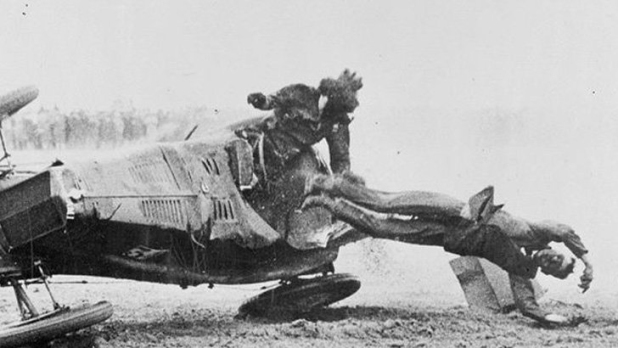 |
A study of motor sport accidents and drivers in 1967. and before, found that virtually none of the drivers involved in accidents in Britain that year, were wearing any form of restraint. In the case of open single seat vehicles those who happened to stay within the cockpit during an accident suffered the least severe injuries, especially in rollover situations. Drivers asked about this at the time responded with the attitude that they would rather be killed instantly, or thrown clear, than be trapped in a burning vehicle and burn to death. This attitude was also very prevalent in USA, even in the enclosed vehicles. |
So, what a seat belt does?
"It stops you going through the windscreen!"
The chances of you actually going through the windscreen as a driver in a car during a collision are actually small, and a belief that this will always happen is largely a myth. To understand this, the next time you get into your car just pause for a moment and think about the seat belt and the job that it actually does.
The front seats of your car are mounted on runners and will have some means of adjusting the forward and rearward position to allow for your height, or at least, the length of your legs. In most cases this will be some sort of mechanical and hand operated device and when you operate the lever or knob you will withdraw a steel pin(s) affixed to the seat and which locate into a groove, slot or one of a series of differently spaced locating holes, along the runners. Those locking pins measure not much different than about half a centimeter in diameter. How much force do you think those locking pins are able to take? The answer to that is certainly nowhere near the amount of force involved during even a small collision, which occurs even at what you may regard as a low speed.
Imagine you are driving at 50 kmh, and without wearing your belt. Through circumstances for which you have not accounted for, or for some other uncontrollable factor, you have a crash into another car or a solid object. In this moment your body will experience the force of several tenths of g-force. Suppose there is force of only 10 g, and that's mean that your body now weights 10 times more. For the unbelted driver the seat adjustment locking pins holding the seat in position sheer off and your seat now runs forward on its runners just like a train on rails. Do you go through the windscreen? Unlikely, as what happens in the real world is that your seat accelerates forward with the speed of about 45 kmh and your knees go into and under the dashboard. This exerts force downward through your lower-legs towards the floor of the car and to your feet. As your feet are on the floor, and remember that the floor may be buckling upward at this point too, that force has to be dissipated somewhere, and to do that is to shatter your legs between knee and ankle - most likely, to shatter your ankles as well. Remember also the seat at this point is still trying to go forward, as more force has yet to be dissipated.
Most will be aware that your upper leg is located and jointed to your pelvis by a ball of bone at the top of the limb, which locates into a socket within the pelvis itself. Now, probably those have gone too, as well as the pelvic bone. If you think this is bad then consider this. By the time the vehicle has come to rest you are probably well and truly trapped, and even if you are still alive at this point, and you are lucky, someone will call for the emergency services. How long does that take for them to get there, and when they do, what happens then? Firstly, you need to be removed from the car, and with two shattered shins, ankles, hips and possibly a broken pelvis, how do you think it is going to feel when a bunch of Fire and Rescue people start pulling and pushing at you in order to achieve this? You will be screaming your lungs out, that is unless you have had your chest caved in by the steering wheel resulting in those being punctured as well!
If you think this sounds too fantastic to be worthy of being considered to be true, ask someone who has been around this kind of accidents and, and who has seen this scenario too many times. It happens with sickening regularity. However, there will still be those who doubt the wisdom, and will do so mainly through some fanciful idea that if they have a smash, their situation will be different.

4 point safety belt from racing version of Renault Megane turbo
Take a look at the clasp part of the seat belt assembly - the part that you slot the buckle of the belt into. What is this fixed to? You will see that it is bolted to the vehicle floor, and if you could inspect it further, you would see that the floor in this area of the car has been re-enforced so as to provide additional strength. The purpose of it being constructed in this manner is that the seat belt doesn't just restrain you within the vehicle, but it actually keeps your seat in place too. That business of your seat running along on its mountings like a train on rails, the seat belt prevents all of that and keeps you back from the dashboard.
So often you can hear "I knew a bloke that was thrown out of his car, which then caught fire. If he had been wearing his belt he would have been trapped in there and would have burned to death."
Think about the supposed scenario. With all those horrific injuries, and whilst trapped in the car with your shattered legs and pelvis, do you honestly believe that you would be able to get out of the car if it caught fire? At least if you had been wearing your belt you would stand some sort of a chance of being fit enough to get clear. Trapped under the dash you have no chance.
In an impact at just 50 kmh your body weight will multiply several times, and sometimes to a point that can be measured, not in kilograms, but in tones. Check g-force article for that. If you ever think you could hold yourself back in your seat with your arms braced to the steering wheel or dashboard, do you think that you are strong enough to cope with the forces involved and that you could stop you and your seat going forward? Not a hope! We are talking about tones of your weight now. With the speed of 50 kmh, and previously supposed force of only 10 g (but always is far more than this), you will experience the weight from 700 to 1200 kg. Can you hold this force with your hands? Suppose your name is Superman and you can take this load. But there is another problem. Your steering wheel is not constructed to support this kind of force.
On the back seats of a car the unbelted passenger is not only in danger of sustaining serious or fatal injuries, but even if they do survive, they stand a very high chance of killing the person in the front seats who is sitting immediately in front of them.
Anyone who does not wear their seat belt because they can't be bothered is a fool, and anyone who doesn't wear it because they don't feel they need to, is an even bigger fool.
So, what's your excuse? It's not a difficult task to perform is it? You unlock the door, get into the driver's seat, put the key in the ignition lock and start the engine. All you have to do now is to reach over your shoulder, grab hold of the belt, pull it across your body and clip it home. So why is it that so many people don't or won't do it?

A badly fitted seat belt won't provide you with proper protection in a crash. It may even cause injuries. And it's likely to be uncomfortable. So it's important to adjust it to give the best fit.
The position of the upper seat belt mounting point determines the angle of the diagonal part of the seat belt, and the fit of the belt across your chest and shoulder. Many modern cars have an upper mounting point that can be slid vertically over a range of alternative positions. If the car has one, use it! Experiment to find the position that allows the belt to pass across your collar bone midway between your neck and shoulder. Too high a position can result in the belt chafing against your neck - and could cause a neck injury in a crash. If the mounting point is too low, the belt could slide off your shoulder in a crash and allow your upper body to be thrown further forward than it should, resulting in damage from contact with the steering wheel.
Whenever you drive a car other than your own, or after somebody else has driven your car, remember to adjust the upper seat belt mounting point after you have adjusted the seat and steering wheel.
Even cars with a fixed mounting usually have at least two alternative threaded holes for the bolt that holds the mounting point to the door pillar (usually concealed under the interior trim). If you find that the standard position doesn't fit you well, it's a simple matter to unbolt the upper mounting point and screw it back on in one of the other positions. Or ask your garage to do it for you.
To be effective a seat belt must fit tightly. Always check that the belt is free of twists when you fasten it, and that the lap part fits across your pelvis - not your waist (a lap belt that's too high can damage internal organs in a crash). Then pull all the slack out of the belt so that it feels tight.
You have to check that your own belt is as well-fitted as possible, and capable of providing maximum protection in a crash.

Safety belt in racing
Despite the breathtaking rate of development in Formula 1 and other racing series, it has taken a lot of time to understand that safety belts can save lives. Although helmets and overalls were stipulated by Formula 1's governing body, as far back as the early '60s, safety belts have only been compulsory features in a Formula 1 car since 1972. The seat belts in a racing car not only give the driver a sense of security, they also directly protect him from serious injury in an accident. In combination with a carbon-fibre monocoque or tubularchassis, HANS, customized seat, helmet and overalls, these belts help make the racing car cockpit a pretty safe place to work.
Formula 1 drivers are strapped into the cockpit by a six or seven point harness, similar to that found in a fighter jet.
Two shoulder straps, two pelvic straps and two leg straps allow them just enough freedom of movement to be able to steer and reach the various switches and buttons in their field of vision.
In a racing car, the drivers are pushed as tightly into their seat, so they need, specially in case of open wheel racers, help of a mechanic to fasten the belts. However, in an emergency, they must be able to leave the car from the normal buckled position within the five seconds stipulated by the regulations, because all the individual belts can be released with a single twist of the hand. The task of the belts is clear: in the case of an accident, they should work with the compulsory Head And Neck Support (HANS) to protect the driver from smashing against the steering wheel, and at the same time they absorb some of the impact energy.
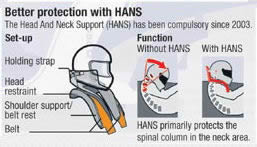
But aside from all that, in order for the seat belts to be effective at the high speed and with the high g-forces of a Formula One car during cornering and acceleration and braking, they must be very, very tight. The driver is incapable of making them tight enough and that is why it requires a mechanic to tighten them appropriately.
The idea of comfort is always relative. In Formula 1, if the belts don't hurt, then they are not tightened hard enough.
Why F1 drivers can't fasten their own seat belts? That has to do firstly with the sitting position of the driver. He sits in the cockpit with his legs raised high, his body low, and above all, there's very little space beside his arms to allow him to manipulate the complicated seat belts. He has no elbow room in the narrow cockpit. The six-point belts meet in a buckle, straddling each shoulder, and up through the crotch and around the waist.
On the one hand, the belts must be strong enough to protect the driver from an impact. On the other hand, they also have to give enough to make sure that the driver is not injured by the belts themselves in an emergency.

The manufacturers of the safety belts and the teams solve this dilemma with the help of extensive experiments that test the strength and the elasticity of the material. Generally, the belts are made of the textile fibre polyester, and have special monofibres woven laterally into them. They act as small laminated springs and keep the belt strap flat. In this way, the load is distributed better over the entire width of the belt strap. The fittings and tabs are generally made of titanium. After an accident, it must be possible to rescue the driver together with the seat from the car if the emergency services think it necessary.
For FIA approval the shoulder straps must be between 44 and 76 millimeters wide. For HANS Use Only harnesses with between 44 and 76 millimeters shoulder strap is allowed. If the HANS Use Only straps are used then a HANS device must be worn to comply with the FIA regulations. For FIA approval the lap straps can be either 50mm or 76mm wide according to driver preference. Crutch straps are 44mm wide. Single Seater style Loop and D crutch straps have a 25cm loop on the end of the 5cm webbing to thread through the D rings.
According to the FIA standard 8853/98, every fastening point of the belts must be able to withstand a load of 14.7 kilonewtons, the equivalent of roughly 1,470 kilograms. Don't forget, there is 6 or 7 fastening points. All together 8.820 kg. Almost 9 tones.
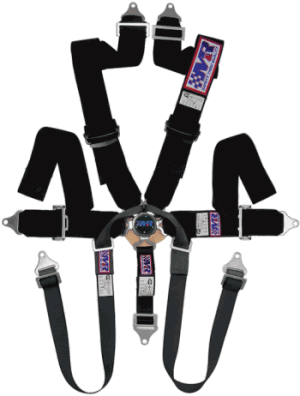
Seven point safety belt
In the auto sport, best known belt suppliers are Willans, Sabelt, TRW, Schroth and Takata.
Sabelt entered Formula 1 in 1979 with Bruno Giacomeli driving his Alfa Romeo.
Willans Harness is the world's leading harness manufacturer, providing essential safety equipment for all forms of motor sports - from club racing and rallying to Formula One, IRL V8 Supercars, BTCC and Nascar. Outside motor sport, Willans reputation for reliable, high quality safety harnesses has led to its involvement in a number of world class projects. These include manufacturing the harness for the Thrust SSC which broke the land speed record in 1997 and also helping the MIR Space Station with research into osteoporosis.
Willans supplied harnesses to both Virgin Atlantic Challenger attempts when Richard Branson smashed the world record for the fastest crossing of the Atlantic achieving this amazing feat in a 72 foot powerboat.
UPRIGHT SEATING POSITIONS

Lap Belt must be anchored to the frame rail or roll cage as close to the hip as possible at an angle of 45 degrees, but no greater than 60 degrees to the ground.
5-Point Belt should be anchored on or slightly behind the Chest Line1.
6-Point Belt should be anchored at an angle of 20 degrees behind the Chest Line as measured from the intersection of the Chest Line and the lap belt buckle. Mounts should be approximately 20 to 30 centimeters apart (approximately located under each hip and as close to the body as possible). Two routing holes in the seat or a special seat mount may be required. Using the 5-Point hole detracts from the effectiveness of this system.
RECLINED SEATING POSITIONS
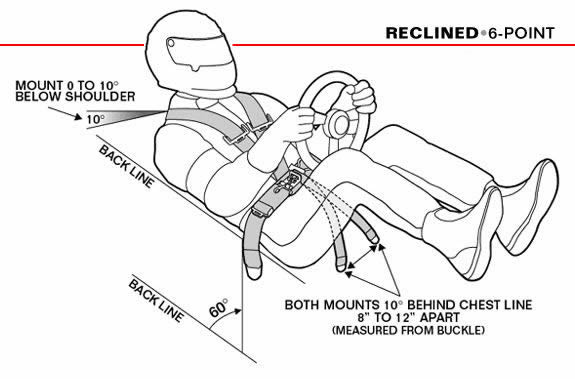
Center Shoulder to Center Hip angles between 30 to 50 degrees to the ground.
Lap Belt anchors must be positioned at an angle of 60 degrees in relation to the Back Line2 and mounted to the frame rail or roll cage as close to the hip as possible.
5-Point Belt should be anchored approximately 10 degrees behind the Chest Line as measured from the intersection of the Chest Line and the lap belt buckle.
6-Point Anti-Submarine Belt should be anchored at an angle of 10 degrees behind the Chest Line |as measured from the intersection of the Chest Line and the lap belt buckle. Mounts should be approximately 20 to 30 centimeters apart (approximately located under each leg, even with the pelvis).
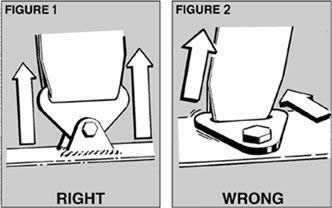
14.4 Safety belts :
It is mandatory to wear two shoulder straps, one abdominal strap and two straps between the legs. These straps must be securely fixed to the car and must comply with FIA standard 8853/98.14.8 Seat fixing and removal :
14.8.1 In order that an injured driver may be removed from the car in his seat following an accident, all cars must be fitted with a seat which, if it is secured, must be done so with no more than two bolts. If bolts are used they must :
- be clearly indicated and easily accessible to rescue crews ;
- be fitted vertically ;
- be removable with the same tool for all teams and which is issued to all rescue crews.
14.8.2 The seat must be equipped with receptacles which permit the fitting of belts to secure the driver and one which will permit the fitting of a head stabilization device.
14.8.3 The seat must be removable without the need to cut or remove any of the seat belts.
14.8.4 Details of the tool referred to above, the belt receptacles and the head stabilization device may be found in the Appendix to these regulations.
14.9 Head and neck supports :
No head and neck support worn by the driver may be less than 25mm from any structural part of the car when he is seated in his normal driving position.
Back to the top of the page






